Elizabete Lucy Dravniek and Jakob Puce were born in the village of Kurmene on December 26, 1882, and January 17, 1880 respectively. Elizabete's family moved from Kurmene to Skaistkalne(s) at some point between 1872 and 1875, a neighboring larger village 13 kilometers down the "road." The two were married on January 7, 1907, either in Skaiskalne(s) or Riga (depending on the account) and left on a ship from Liepaja (a major port on the Baltic Sea) with a stop in Liverpool on their way to Canada.

Jakob Puce, Lonija Brown, Elizabete Puce, Duward Brown, Lonija Brown (Burroughs) on Lulu Island, British Columbia, around 1956.
Brief History
We found some nice history in a booklet that was published by the Latvian Embassy soon after independence in 1991--the English translation is a little rough, but still useful.
"While foreign rulers came and went, beneath the surface of national affairs, native Latvians sturdily maintained a national identity of tradition and folklore. Emancipation came in 1861 through the agrarian reforms of Czar Alexander II. This sparked the national awakening. The spirit of freedom was abroad in the land. From then on it was destined to be dampened but never extinguished. In 1889 Czar Alexander III embarked on a policy of ruthless Russianization, to engender hatred but not success. There was brief hope for independence in the abortive Russian revolution of 1905 when Latvian actually administered their own local affairs for a short while. A year later reaction gained the upper hand in Russia and the Latvian national revolt was drowned in blood and tears."
The family story was that Jakob Puce was involved in fighting against the Russians for Latvian freedom and worked for the local government, and had to flee to Canada because his life was in danger. This account fits into the historical timeline--that he fought for Latvian freedom successfully in 1905, and was involved in the local government until the Russians regained control of the country. Russians had a knack for hunting down dissidents, sending them to Siberia or brutally eliminating them, making it extremely dangerous for Jakob Puce to remain in a tight knit, small rural village. He and his new wife Elizabete traveled with her brother Juris Dravniek and his family (wife Julia who was pregnant, daughters Alvina, Lucy, and Martha and sons Rudolph and George) to Winnipeg, Canada to work for another brother Joseph Dravniek who ran a boarding house and a grocery store in the same building.
Conception of the Plan
Why did we go to Latvija? It had always been on the hypothetical wishlist...Elizabete even found a psychology conference that her father could go to and tag along, but that didn't work out so well. We started planning seriously last year together with friends who have a son in the foreign service who is stationed in Riga. Then in January Lonija stumbled across frequent flyer tickets (Honolulu to London for 50,000 miles!)--attributed to ancestors pulling some strings, and we were on our way.
We made it!



Riga International Airport (Starptautiska idosta Riga)
Jurmala


We arrived in Jurmala, a coastal town on the Baltic Sea about 20 minutes from Riga. We stayed at the "Balta Puce" (White Owl) because it's the family name which obviously means owl. We weren't disappointed, there were owls everywhere. Grandma Brown would have really liked the place.

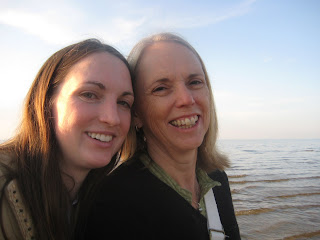

The beach at Jurmala was very similar to the beach in Grayland, Washington-same gray sand, same flatness and firmness (but just bikes, no cars allowed) and warm enough that day to enjoy a sunset stroll.

This woman was walking across the sand spits, carrying her handbag and wearing her hat and church shoes.



Want to buy a condo in Jurmala? Only about $500,000!


We walked back into the cobblestone center of town...where we bought some drinks and candy bars at the local "7-11ish" store (Lonija thought the raspberry cider named FIZZ looked interesting...but it turned out to be hard cider, alcoholic content not to be mentioned here)...and Elizabete found some turtle friends. You'll note that it's still really light outside, even though we took the sunset picture about 45 minutes before (it got dark around 10:30).

Salmon Dinner at the Balta Puce...perfect end to day one.
Rail to Riga-Day two!


We decided that it was too hard to try and drive and park in Riga (a very good decision) so the hotel people who spoke very good english told us to take the train at Majori...on the way we ran into this charming fellow.
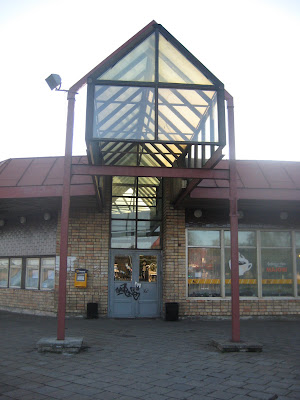
Majori Train Station (and not an abandoned coffee shop, we walked right by it at first-very Soviet era and even frightening in its graffiti covered coldness).


We managed to get on the correct train to Riga - on the way we passed some of the many stands of whitebirch trees. (there are also vine maples)

Soviet era communal apartments - you were allotted a predetermined square footage with a communal bathroom.
OLD TOWN RIGA



After the rain we ventured out into the cold.



We wandered the cobblestone streets of Old Town Riga -ran into St. Jacob's Church (the red brick building) and just soaked in the agedness of everything. What was it like for rural villagers Jakob and Elizabete Puce to walk on these same cobblestones?

Looking down this street you can see the Powder Tower (Pulvertornis). It was one of Riga's fortification towers dating from 1330 (but rebuilt many times)

We were heading toward the Freedom Monument when we saw one of the few crowds of people that day - where else? the Golden Arches! McDonald's was the only US business that we encountered on the trip, but so close to the monument?


The Freedom Monument (1935) is the symbol of Latvian independence. It stands on Brivibas iela (street) and has three stars representing the sections of the country. We got there the day after one of Latvia's independence celebrations so it was decorated with flowers. The flower map of Latvia had mostly tulips, daffodils, hyacinth and forget-me-nots. This is a serious place and people do not walk up the steps or sit on the stairs. (luckily Elizabete pointed this out before Lonija made any grave cultural errors). The monument was erected on a spot where a statue of Peter the Great stood originally and bears the inscription "Tevzemei un Brivibai" (for Fatherland and Freedom). At one point during the Soviet era they contemplated removing the monument since it served as a focus of independence but they feared the reaction and instead erected a statue of Lenin. The two statues stood back to back for decades, Lenin facing east and the Freedom Monument facing west. Lenin disappeared in August 1991 after the collapse of the Moscow coup attempt.

This is the area on the map our family is from.


There is a park surrounding the monument and in the second picture is a small bridge that is used for couples to make commitments to one another. The shiny objects on the bridge are locks that couples bring and affix to symbolize their love.

 a
aAcross the street is a row of embassy buildings - German, French and US - can you tell which they are? (hints: the largest cars go the the US, France is blue and Germany is brown)

Ratslaukums Square was destroyed during WWII but it has been restored - this is the House of Blackheads, the Guild of Unmarried Merchants.



On the other side of the square is the "chilling yet spirited Museum of Occupation of Latvia" (from our guidebook) It was originally built in the 1970's by the Soviets and was almost razed because of its "ugliness" but is now a museum outlining the occupations of Latvia from 1915 to 1991. The statue is also clearly a Soviet reminder of the Moscow occupation. We visited the museum later in the week and it was an emotional time. The Russian, the Nazi and finally the Soviet occupations of Latvia were long, brutal, degrading and confusing. We could imagine how Jakob and Elizabete would read of these events in their Latvian newspapers and agonize over what was happening in their country. The guilt must have been overwhelming, they were safe but their countryman were not. If they had stayed they would have been brutally murdered or slowly died in Siberia, but they couldn't help anyone that they loved who was still in Latvia. In 1914, more than half of the population of Skaistkalne Pagast (their home) was "relocated" to Siberia (closer to 70% as we recall)-a shocking discovery. The influence of our ancestors during the visit to this museum cannot be put into words.


One of the times we felt direct influence from the ancestors was after we left the square on our way back to the train station. We felt it was important to begin heading back even though it would be daylight for awhile. Crossing the highway seemed the way to go and initially we had this great view of the Daugava River, but as we walked along it started to look pretty deserted and run down. We kept going thinking it was the right thing to do and then we stumbled on the 1905 Monument. It was Jakob Puce! This is a monument that is rarely visited but we recognized that we had been carefully led there. Thank you Grandpa Puce.


We could see our train now so we managed to find a moderately safe way to cross back over the highway to the station. We didn't get a picture of the front of the several million dollar modernized station, but we did get a picture of our platform when we finally found it - not so modern.

DAY THREE--Finding the villages of Elizabete and Jakob Puce



So, armed with our nacho cheese puffs and maps we started down the road from Jurmala to Skaistkalne.

The roads brought views of farms and forests

Fields of dandelions are everywhere.




A word about driving in Latvia - terrifying
We are smiling in the pictures because thus far we had escaped imminent injury.
The other pictures are of a double semi truck passing me at over 100kmh where the speed limit is 70 kmh. You can also see that there are vehicles coming straight at us - it's like Mario Cart on acid. Everyone drives as fast as they can, people move over as much as the road allows and the center line becomes a suicide lane.



We made it safely to Berzkalni Hotel in Bauska, the closest lodging to the villages we wanted to get to. We were in the Lily of the Valley room complete with MTV (with captions) and BBC (the only English station). We stopped at the Rimi market on the way where I picked up a few piragi's. The smell of piragi's was that of childhood in the Shady Lake house.

The road to Skaistalne was about 50 km and became dusty gravel, eventually one lane.



We made it to Skaistkalne Pagast (it's like "Greater Skaistkalne") and found our first cemetery (kapi). There are many above ground stone or concrete "boxes" in all the cemeteries, most of which do not have any names on them.
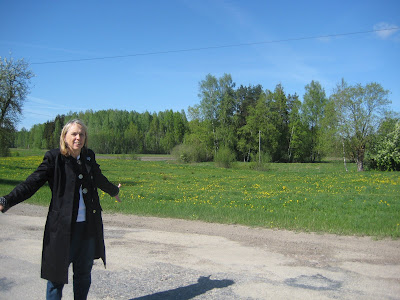
Here it is...

We made it!

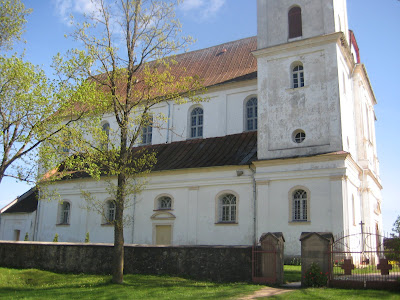
As we entered the village we could see the church on the highest hill. (kaln means hill) More on the church on day four.


Views of the village from the church - note the paths leading up the hill to the church.
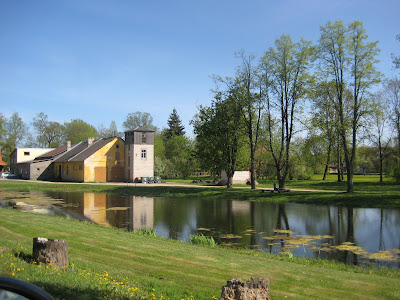


The pond and community center with maps. Skaistkalne is actually right on the border with Lithuania. The first day we started to drive over the bridge but noticed there were guards in uniform-a little unsettling considering there are not supposed to be any borders in the European Union anymore based on the Schengen Agreement. We waited until the next day to take a quick drive over the border.

The road to Kurmene is about 13 km along a one lane winding gravel road much of which follows the river that divides Latvia and Lithuania.



Just before Kurmene we found another kapi alongside the river, still no family names.

The Latvian culture does include supernatural, mystical beginnings which seem to include a belief that storks will bring a farm good luck. The farmers build these high nests to lure the birds to migrate to their farms - we saw several on the trip to Kurmene.

Kurmene! It really does exist! (along with nettles in the grass)

Kurmene Skola - Elizabete and Jakob did not live in a time when children went to school. As she explained to me, the church wanted to keep control over the people and it was easier if they weren't educated. Parents were punished for teaching their children to read, but her mother hid the books and taught her only when it was safe. Since the men and boys were in the fields it was much harder for them to learn to read and yet Jakob learned somewhere because I used to watch him read the Latvian newspapers when we visited them.


These buildings must have been there when Elizabete and Jakob lived in Kurmene.


This is the church in Kurmene - it is either this church or the one in Skaistkalne that is the site of stories Elizabete used to tell about the Russian occupation. She always said there couldn't be any geneaology records for our family because when the Russians occupied the villages in the late 1800's they used the church as a stable for their horses. She said it was to demean the people and to destroy their history by destroying the family records. We couldn't get inside this church but the upkeep of the grounds (including pansies planted in the front) indicate that the building is currently being used. We'll have to wait for the Latvian government postings of the church records which is currently underway to see if these churches will be listed. Maybe some records survived - we'll hope.


After a fulfilling day of dusty roads and tiny villages we returned to our lodgings in Bauska to some fabulous food - chicken salad, cheese plate, and banana pancakes. And don't forget the dark rye bread!





After dinner we explored the area around Bauska and ended up near the Memele River at the Bauska Castle (Bauskas pils). This castle comes from the mid 15th century built by the Livonian knights. The cannon wasn't working.
DAY FOUR-Back to the villages...

We were back in Skaistkalne the next day trying to find more family clues at the church. Alongside the church is this old abandoned Pauline Monastery.


To the right of the old monastery there are two small houses, one in which the current priest lives. Even though we were seen coming and going for two days, no one approached or questioned us at any time. I still hoped there would be an opportunity to ask some questions about church records so as we were ready to leave I approached the priest's house and rang the bell for him. He did not speak any English (only perhaps some "Germanski" that he offered) but he signaled for me to wait and he came back with what can only be described as a key ring and key out of a medieval movie/cartoon - it was large enough to need two hands to carry it! I understood that he was intending to open up the church and let us visit - he did unlock the door, show us in, and then quickly departed.




It is clear now why Elizabete Puce had such low opinions of religion. She felt the church was just an arm of the government oppressors, using money to decorate its building while ignoring the needs of the people. It is an impressive sight throughout -carved, painted, gilded and in every way beautifully appointed. However there is no heat and no plumbing.

The church outhouse.


It was time to leave the church.
 The search for cemeteries continued - this is what appears to be an abandoned military cemetery that is entirely in German.
The search for cemeteries continued - this is what appears to be an abandoned military cemetery that is entirely in German.

We found two more cemeteries in Skaistkalne, one with an old well and the other larger, currently in use. We searched amidst rain and swarms of very hungry mosquitoes for family names on all the graves and family plots but found no Puce, Dravniek, Celmis or Bulis. It is absolutely clear that no one with those family names remains in the area or at least maintains a family area in the cemetery.



There was one unusual section of the cemetery in the front corner - it was very overgrown and looked like no one had stepped into the area for many years. All of the headstones looked like they were from the exact same time period - perhaps a plague had taken them all at the same time? As we looked more closely we realized that the headstones were in Hebrew. On that somber note we had to leave.

It is always clear when you are leaving, as we were, Skaistkalne. We had one more adventure on this day. It was time to find the Rundale Palace just west of Bauska. It was built in the 18th century as a summer palace by the Italian architect Francesco Bartolomero Rastrelli who had already done the Winter Palace in St. Petersburg. It was built for Anna, a niece of Czar Peter I who married Frederick, Duke of Kurland-literally in the middle of the countryside.


The view from outside in and inside to out. The cobblestones in the courtyard are placed in a star design.

Inside we are royalty.


The throne room


The Grand Gallery



The Ballroom






The Rose Room, Blue Room, Green Room In the corner of the rooms you can see blue tile structures - it's the heat sources.

Period gowns



Outside we inspected the formal gardens and the hunting grounds beyond.
DAY FIVE-Back to Riga


Back on the road again to Riga. It is interesting to note the yards and fields of dandelions - there seems to be no fear of or need to destroy them.

We arrived in Riga and were graciously housed and aided by Ryan and Matina Roberts in their Riga apartment. Ryan is in the US Foreign Service in Latvia and helped us considerably with background information.

From their apartment we made our way to Elizabetes own street.




We made our way to Alberta iela to view one of the largest collections of Art Nouveau buildings in Europe.
DAY SIX-Last full day in Latvia :-(



One of the mysteries that is unknown is where Jakob and Elizabete were married, Skaistkalne or St. Peter's in Riga. Both places have been listed in the family records. One scenario that would make sense is that in January 1907 their names were too well known to risk the filing of a marriage in their small village churches. In that case it would make sense that they traveled to the relative anonymity of Riga to get married then traveled to Liepaja where they boarded the ship to Liverpool.



We took the elevator to the top where you can view the city of Riga.


House of the Cat
A Latvian businessman wanted to be admitted to the Guild and after being rejected built this house and had two black cats with arched backs placed on top with their backsides faced toward the guildhall. After court proceedings he was finally admitted into the formerly German guild if he would move the cats to their current positions.

The Swedish Gate was built onto the city walls in 1698 and is the only remaining old city gate.
It also contained the only tour group we encountered during our visit.


We ate at Lido our last night there. I finally found pickled herring just like Grandma Puce used to make!
 Forget-me-not
Forget-me-not
4 comments:
Yes I am the first to comment...
Thanks for sharing all the pictures and thoughts
It really strange that no one would ask where you were from or why you were traveling there, it seems like such a natural question. It makes me wonder if there are a lot, a little, or hardly anyone else that goes to learn more about their family history ect. Well you have certainly got me to thinking thanks for taking the time to put that all together for everyone else to see.
Duward Jakob
girlfriend, that was awesome. just got a chance to read about your trip lonija and WOW!! i wonder how many people can say that they flew the shaka sign in latvija? among many things your ancestors are most certainly proud of.
Amazing trip and amazing country. I am so glad you got to see a glimpse of communism, the country-side, european architecture, and most importantly, your roots! I'll have to hear more
Wonderful to read your story and see the great pictures. It brought back memories of my trip to Latvia last summer.
My mother was born in Riga in 1918 but left with her family when she was very young. Her ancestors were from Dursupe (near Talsi) in Kurzeme.
Post a Comment